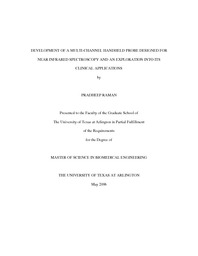
ATTENTION: The works hosted here are being migrated to a new repository that will consolidate resources, improve discoverability, and better show UTA's research impact on the global community. We will update authors as the migration progresses. Please see MavMatrix for more information.
Show simple item record
| dc.contributor.author | Raman, Pradheep | en_US |
| dc.date.accessioned | 2007-08-23T01:56:52Z | |
| dc.date.available | 2007-08-23T01:56:52Z | |
| dc.date.issued | 2007-08-23T01:56:52Z | |
| dc.date.submitted | April 2006 | en_US |
| dc.identifier.other | DISS-1223 | en_US |
| dc.identifier.uri | http://hdl.handle.net/10106/497 | |
| dc.description.abstract | Near Infrared (NIR) spectroscopy and imaging has become popular in research fields for the past 2 decades. My research focuses on the development of a handheld, multi-channel, multi-separation probe for the low-cost, compact, NIR spectroscopy (LCC-NIRS) system and also on the exploration into its possible clinical applications. The work is divided into three parts. The first part deals with the development of the multi-separation probe with source-detector separation of 3.8 cm, 3.3 cm, 3.0 cm, and 2.3 cm. The probe is designed to work as a tri-wavelength system for the LCC-NIRS, which was developed earlier, consisting of one light emitting diode (LED) as the source and four photo detectors. The source is a tri-wavelength LED, emitting light at 730 nm, 805 nm, and 850 nm. The physiological data was acquired from four, multi-separation channels, while the LED light switched between the three wavelengths.. The probe holder was designed to the specifications of the multi-separation probe as discussed earlier. It was made using VeriSiTal (VST) silicone elastomers, a new concept in silicone technology. A laboratory phantom experiment was done to validate the new probe's functionality with the LCC-NIRS system to detect Hb (deoxygenated hemoglobin) and HbO2 (oxygenated hemoglobin) changes occurring inside the tissue phantom. The phantom was made with a static blood phantom using horse blood mixed with intralipid solutions.
In the second part, the LCC-NIRS system's possible clinical application, i.e., as a screening tool for the detection of sleep apnea, was explored using the breath holding protocol. In persons with obstructive sleep apnea, there is a reduction in their oxy-hemoglobin saturation (O2 saturation), due to the cessation of airflow, resulting from the progressive collapse of the upper airway. This is simulated using the breath holding protocol. The results obtained proved that the LCC-NIRS system was able to detect the hemodynamic changes during the protocol used.
In the third part, LCC-NIRS system was employed to measure hot flashes, one of the most common and troublesome symptoms of menopause. The studies proved very fruitful as the system was able to detect changes in local blood volume during hot flash events.
Further development can be done to add many features to this LCC-NIRS system so as to make it more compact and eventually a wireless system, which can be very helpful for other clinical uses. | en_US |
| dc.description.sponsorship | Liu, Hanli | en_US |
| dc.language.iso | EN | en_US |
| dc.publisher | Biomedical Engineering | en_US |
| dc.title | Development Of A Multi-channel Handheld Probe Designed For Near Infrared Spectroscopy And An Exploration Into Its Clinical Applications | en_US |
| dc.type | M.S. | en_US |
| dc.contributor.committeeChair | Liu, Hanli | en_US |
| dc.degree.department | Biomedical Engineering | en_US |
| dc.degree.discipline | Biomedical Engineering | en_US |
| dc.degree.grantor | University of Texas at Arlington | en_US |
| dc.degree.level | masters | en_US |
| dc.degree.name | M.S. | en_US |
| dc.identifier.externalLink | https://www.uta.edu/ra/real/editprofile.php?onlyview=1&pid=28 | |
| dc.identifier.externalLinkDescription | Link to Research Profiles | |
Files in this item
- Name:
- umi-uta-1223.pdf
- Size:
- 1.836Mb
- Format:
- PDF
This item appears in the following Collection(s)
Show simple item record


